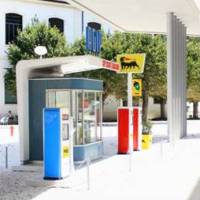City and Energy Infrastructures between Economic Processes and Urban Planning
Abstract
The paper deals with the issues related to the relationship between city, energy, economic factors and city planning. These issues are analyzed from a theoretical point of view and are placed in a logical path based on three assumptions. The first considers the city as an intelligent system constantly evolving. The second considers the city as a system where economic processes come out at their highest level affecting other aspects of social and urban structure. The third considers the planning as the weak link in the process of urban development, one of the most exposed to economic and social pressures.
Energy production has experienced a great progress since steam and electricity were discovered. Each stage of this evolution has affected city and territory introducing significant physical signs, changing the ways of carrying out functions and creating new needs and new activities. The energy revolution, based on sustainable sources and on skillful management of the networks, will strongly affect the city and the way of organizing the activities, their location, dimension, and the shape of the spaces.
The paper explores some of the issues related to the relationship between urban system and energy.
The first section analyzes the meaning of the intelligent city as an entity that is constantly changing and constantly adapting. The second section analyzes the role of the energy systems in the evolution of the activities and of the city’s image. The last section investigates the role of the economic factors in the evolution of the shape and meaning of city, pointing out that the way towards smart and green urban systems will largely depend on their economic advantage.
Downloads
References
Augé M. (2005), “Per inventare un nuovo futuro”, la Repubblica, 1° febbraio 2005.
Batty M. (2011), Building a science of cities, UCL Working Papers, Series No. 170, November, UCL, London.
Bauman Z. (2013), Lo spirito e il clic. La società contemporanea tra frenesia e bisogno di speranza, Edizioni San Paolo, Cinisello Balsamo.
Berry B. (1964), “Cities as systems within systems of cities”, in Papers and Proceedings of the Regional Science Association, 13, 147–164.
Berthon B., Guittat P. (2011), “Ascesa della città intelligente”, Outlook, n. 2, giugno, http://www.accenture.com/it-it/outlook/Pages/index.aspx.
Castells M. (1989), The informational city: Information technology, economic restructuring and the urban-regional process. Blackwell, Oxford.
Cheli E. (2010), Olismo la scienza del futuro. Verso una civiltà ecologica, pacifica e consapevole, Xenia edizioni, Milano.
Cianciullo A. (2013) “Energia intelligente”, la Repubblica, 2 ottobre.
Ciorra P. (2013), “Cura energetica”, in P. Ciorra (cur.), Energy. Architettura e reti del petrolio e del post-petrolio, Electa, Milano.
Dales J. (2013), What people have done, people can do: Or can they?, http://www.rudi.net/node/57890, Access: 3 luglio 2013.
Dubeski N. (2001), “Durkheim’s Altruism As The Source Of His Social Holism: A Discussion Of The Viability Of A Social Basis For Moral Principles”, Electronic Journal of Sociology. http://www.sociology.org/content/vol005.003/dubeski.html.
Eames M., Dixon T., May T, Hunt M. (2013), “City futures: exploring urban retrofit and sustainable transitions”, Building Research & Information, 41:5, 504-516.
EEA, European Environment Agency (2013), Towards a green economy in Europe. EU environmental policy targets and objectives 201-2050, Report 8, EEA, Copenaghen.
EU, European Union (2007), Presidency conclusions, Council of the European Union, Brussels, 8/9 March 2007, 7224/1/07, rev. 1.
Fenn J., Raskino M. (2008), Mastering the hype cycle: how to choose the right innovation at the right time, Harvard Business Press, Harvard.
Fistola R. (2013), “Smart city. Riflessioni sull’intelligenza urbana”, TeMA, Journal of Land Use, Mobility and Environment, 6:1, 47-60.
Gramsci A. (1975), Quaderni dal Carcere, Einaudi Editore, Torino.
Grotewold A. (1959), “Von Thunen in Retrospect”, Economic Geography, 35:4, 346-355.
Hall P. (1998), Cities in civilization, Pantheon, New York.
Lévy P. (1996), L’intelligenza collettiva. Per un’antropologia del cyberspazio, Feltrinelli Editore, Milano.
Lyotard J.-F. (1981), La condizione postmoderna. Rapporto sul sapere, Feltrinelli Editore, Milano.
Longo A. (2013), “Privacy zero”, L’Espresso, 18 luglio, 100-102.
Maugeri L. (2013) “Quanto costa agli USA il primato del petrolio”, l’Espresso, 17 luglio, 112-113.
Mazzeo G. (2010), “L’Expo 2010 di Shanghai e lo sviluppo della Cina”, TC trasporti & cultura, X:27-28, 16-23.
Mazzeo G. (2013), “Valutare la rigenerazione urbana: verso una certificazione di resilienza per le città”, Contributo al XXVIII Congresso INU “Città come motore dello sviluppo del Paese”, Salerno, 24-26 ottobre 2013, in Urbanistica Dossier on line, n. 4, 2013, 169-171.
Moccia F.D. (2013), “Per una metropoli resiliente”, Urbanistica Informazioni, 248, marzo-aprile, 64-66.
Papa R. (1993), “Architettura e nuove tecnologie verso la città intelligente”, in AA.VV., Progettare e costruire per il 2000, CNR-IPiGeT, Università di Napoli Federico II – DiPiST, Napoli, 17.
Papa R., Gargiulo C., Galderisi A. (2013), “Towards an ur

Copyright (c) 2014 Tema. Journal of Land Use, Mobility and Environment

This work is licensed under a Creative Commons Attribution 4.0 International License.
Authors who publish in this journal agree to the following:
1. Authors retain the rights to their work and give in to the journal the right of first publication of the work simultaneously licensed under a Creative Commons License - Attribution that allows others to share the work indicating the authorship and the initial publication in this journal.
2. Authors can adhere to other agreements of non-exclusive license for the distribution of the published version of the work (ex. To deposit it in an institutional repository or to publish it in a monography), provided to indicate that the document was first published in this journal.
3. Authors can distribute their work online (ex. In institutional repositories or in their website) prior to and during the submission process, as it can lead to productive exchanges and it can increase the quotations of the published work (See The Effect of Open Access)
